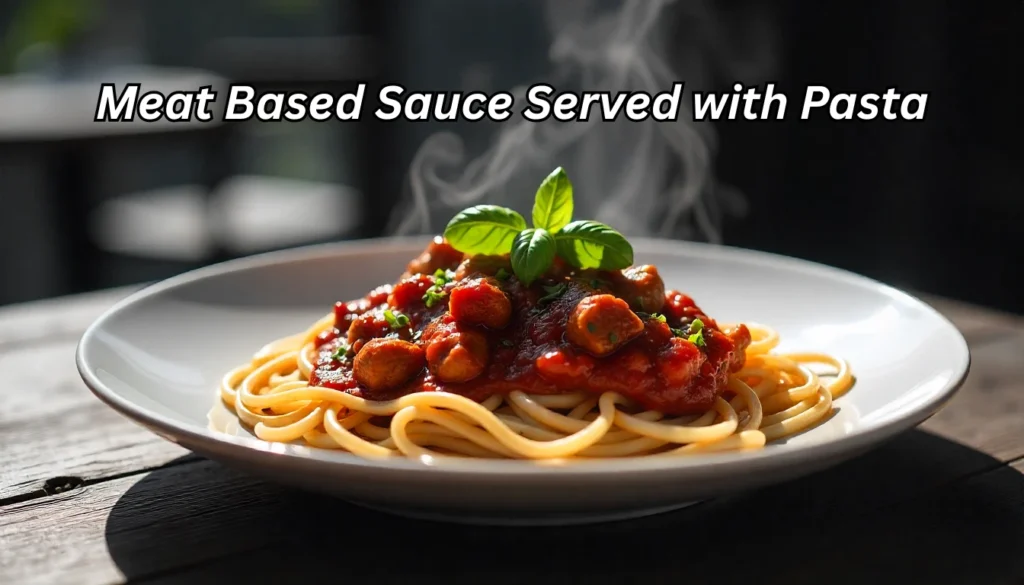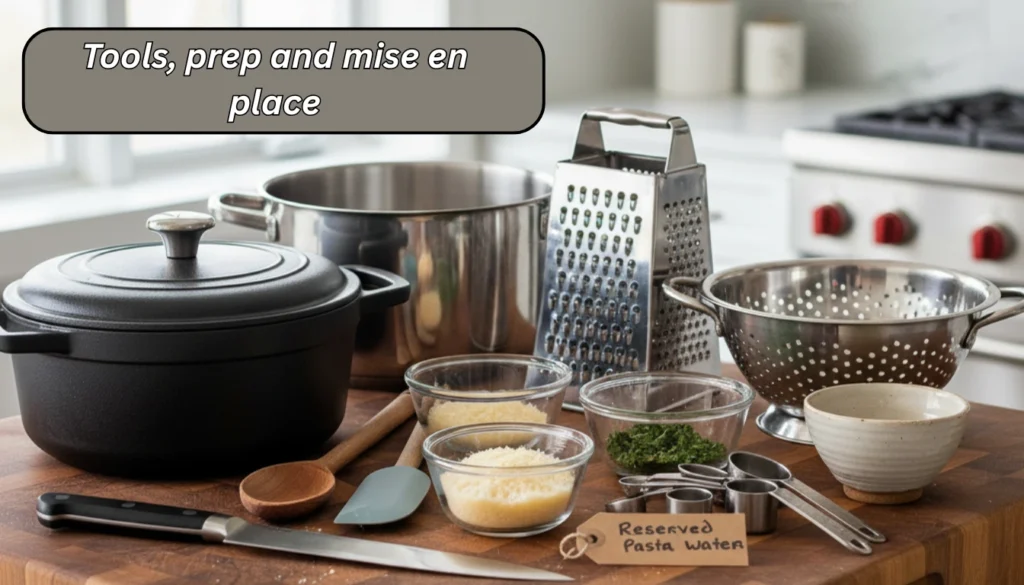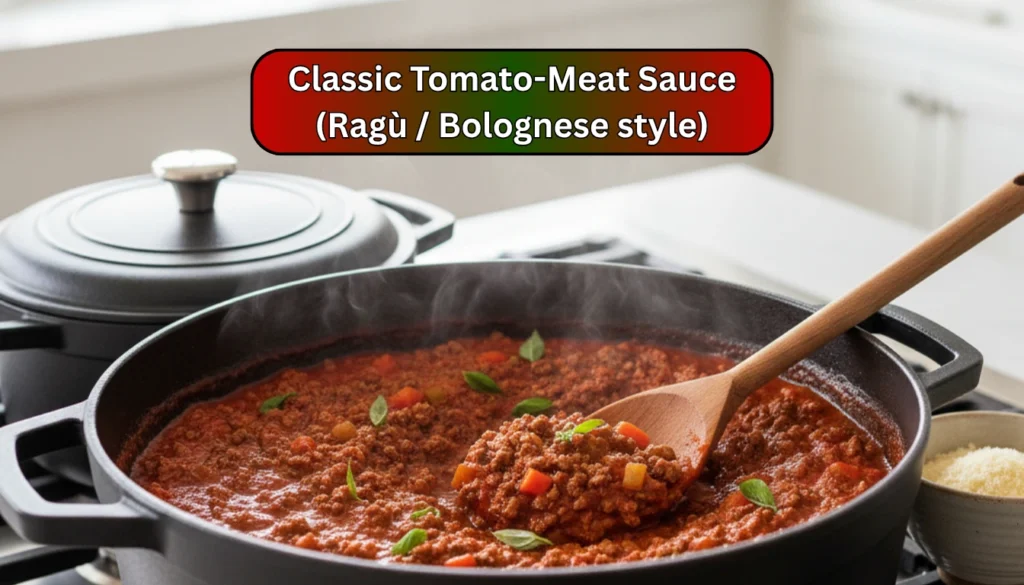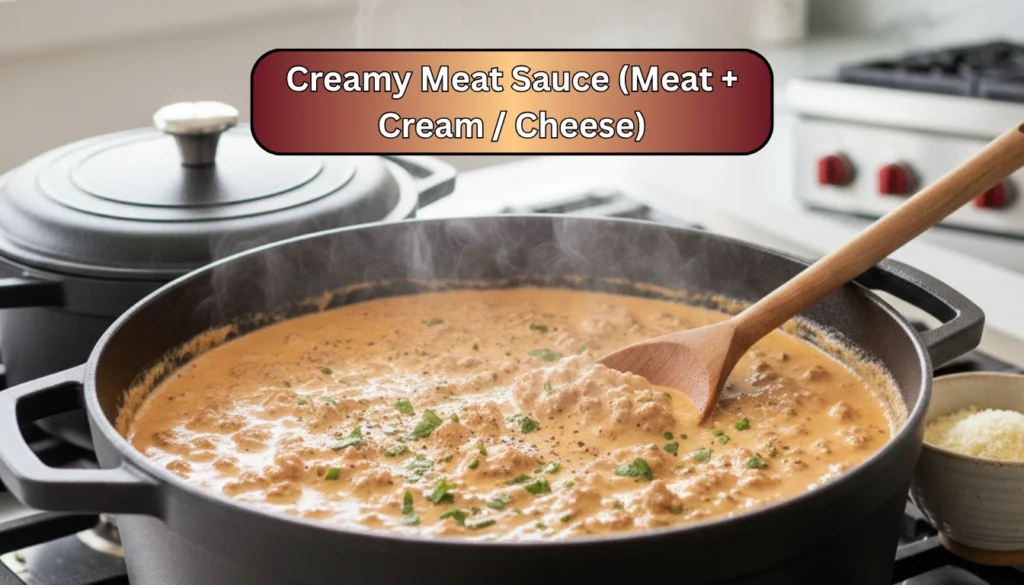
A Meat Based Sauce Served with Pasta is the kind of meal that fills the kitchen with aroma and fills the table with smiles. Whether it’s a family dinner or a weekend comfort meal, a good meat sauce is comforting, rich, and satisfying.
So, you can make a restaurant-quality meat based sauce served with pasta at home. This guide gives you everything: exact ingredient lists, full step-by-step cooking instructions, timing, little tricks I’ve learned from experience, and variations (including Ragù, Bolognese, and other entries from the list of meat-based sauces). Follow the steps exactly and you will not miss a thing.
Now let’s begin by understanding what we mean by a meat sauce, the common types of meats used, and the tools and prep that set you up for success.
What is a meat based sauce served with pasta?
A meat based sauce served with pasta is any pasta sauce in which the primary ingredient is meat: ground or chopped beef, pork, lamb, sausage, veal, or a mix. These sauces are usually prepared using aromatics (onion, carrot, celery), garlic, tomatoes or cream, wine or stock, and herbs. They are robust, filling, and often used not only with pasta but also as sandwich fillings or baked into casseroles.
Below is a quick bold list of the classic list of meat-based sauces to give context before we cook:
- Ragù
- Bolognese
- Caruso sauce
- Carbonara (pancetta/guanciale based)
- Cincinnati chili
- Saltsa kima
Each of these has a different balance of meat, tomato, dairy, and spices — and I’ll reference them where relevant.
Tools, prep and mise en place (don’t skip this)

Before you cook, gather and prepare everything. Doing this avoids mistakes.
Tools
- Large heavy skillet (12-inch/30 cm) or Dutch oven (4–6 qt)
- Large pot for pasta (6–8 qt)
- Wooden spoon and spatula
- Fine grater (for cheese)
- Chef’s knife and board
- Colander and measuring cups/spoons
- Small bowl for reserved pasta water
Mise en place (do these first)
- Chop: 1 onion, 2 carrots, 2 celery stalks into small dice (~1/4 inch). Mince 3–4 garlic cloves.
- Measure: 1 can crushed tomatoes, 2 tbsp tomato paste, 1 cup red wine (optional), 2 cups stock.
- Weigh meat: 1 lb (450 g) ground beef or a mix — see types of meats below.
- Grate cheese, ready herbs.
- Bring pasta water to boil near the end of the sauce simmering.
I always prepare everything first; it makes the cooking calm and precise. Trust me — it helps.
Ingredients overview — choosing the right types of meats
Common types of meats for these sauces:
- Ground beef (80/20 works well for flavor and fat)
- Ground pork (adds sweetness and tenderness)
- Ground lamb (strong flavor; good in Mediterranean versions like Saltsa kima)
- Italian sausage (adds spice/herb notes)
- Ground veal (used in classic Bolognese blends)
- Mixes: beef + pork, or beef + sausage (recommended for depth)
My tip: For most home cooks, a 50/50 mix of beef and pork gives excellent texture and flavor for a Ragù/Bolognese style sauce.
Recipe 1 — Classic Tomato-Meat Sauce (Ragù / Bolognese style)

This is the foundational meat based sauce served with pasta recipes. Read the full steps before you start.
Ingredients (4–6 servings)
- 1 lb (450 g) ground beef (or 50% beef + 50% pork)
- 2 tbsp olive oil
- 1 medium onion, finely diced (about 1 cup)
- 2 carrots, finely diced (½ cup)
- 2 celery stalks, finely diced (½ cup)
- 3 garlic cloves, minced
- 2 tbsp tomato paste
- 1 cup (240 ml) dry red wine (optional)
- 1 can (28 oz / 800 g) crushed tomatoes
- 1 cup low-sodium beef or chicken stock
- 1 tsp dried oregano, 1 bay leaf
- Salt & pepper to taste
- 2 tbsp unsalted butter or splash of heavy cream (optional, to finish)
- Fresh parsley and grated Parmesan to serve
Step-by-step method
1. Heat pan & start meat browning (10–12 min)
- Use a large heavy skillet or Dutch oven over medium-high heat. Add 2 tbsp olive oil — it should shimmer but not smoke.
- Add half the ground meat in one flat layer. Let it sit 2 minutes untouched to form color, then break up with a spoon and stir. Continue browning for 6–8 minutes, turning pieces so they develop deep brown bits. Do not rush; brown = flavor.
- If you use fatty meat, you may have excess fat. Spoon out and discard all but about 1–2 tbsp (leave some fat for flavor). Do not rinse the pan.
Why this matters: Proper browning (Maillard reaction) creates the flavor foundation your sauce needs.
2. Add aromatics (soffritto) (6–8 min)
- Reduce heat to medium. Add diced onion, carrot, and celery. Stir to coat in fat.
- Sauté until vegetables soften and onions become translucent — about 6–8 minutes. Stir often so carrots gently soften and sugar begins to develop.
- Add minced garlic and cook for 30–60 seconds until fragrant. Don’t let garlic brown.
3. Tomato paste browning (1–2 min)
- Push mixture aside and add 2 tbsp tomato paste. Let it cook for 60–90 seconds, stirring, until it darkens slightly — this caramelizes the paste and intensifies umami.
4. Deglaze with wine (2–3 min)
- Pour in 1 cup red wine, scraping brown bits from the pan with a wooden spoon. Raise heat to medium-high for a minute to let alcohol cook off and flavors concentrate.
- Let the wine reduce by about half — about 2–3 minutes.
5. Add tomatoes/stock & herbs (2 min)
- Stir in crushed tomatoes and 1 cup stock. Add oregano, bay leaf, and a good pinch of salt & black pepper.
- Bring to a gentle simmer.
6. Low simmer & reduce (45–90+ min)
- Reduce heat to low so the sauce barely bubbles. Simmer uncovered for 45 minutes minimum. Stir every 10–15 minutes, scrape bottom and check consistency.
- Longer simmering (1–2 hours) deepens flavor. If the sauce becomes too thick, add small amounts of stock or reserved pasta water.
- Taste and adjust salt/pepper after 30–45 minutes — flavors concentrate during simmering.
7. Finish & emulsify (1–2 min)
- Remove bay leaves. Off heat, stir in 1–2 tbsp butter or a splash of cream for silkiness. Check seasoning.
- If the sauce tastes very acidic, stir in a pinch of sugar (1/4–1/2 tsp) to balance.
8. Cook pasta & combine
- While sauce simmers near the end, bring a large pot of water to a vigorous boil. Add 1 tbsp salt (it should taste like the sea). Cook pasta according to the package until al dente (one minute less than package if unsure). Reserve ½–1 cup pasta water, drain.
- Add pasta to a sauce pan or toss sauce with pasta in a large bowl. Use reserved pasta water (1–3 tbsp at a time) to loosen and help the sauce cling.
Serving: Plate, top with grated Parmesan and chopped parsley. Serve hot.
Personal experience note: I learned to brown the meat in two batches for even coloring — it changed my sauce from “okay” to “deep and rich.” Overcrowding the pan is a common home cook mistake.
Recipe 2 — Creamy Meat Sauce (Meat + Cream / Cheese)

A richer version, lovely with penne or rigatoni.
Ingredients (4 servings)
- 1 lb ground Italian sausage (mild or spicy) or 50/50 sausage + beef
- 2 tbsp olive oil
- 1 small onion, finely chopped
- 2 garlic cloves, minced
- 1/2 cup dry white wine (optional)
- 1 cup heavy cream
- 1/2 cup grated Parmesan (fresh)
- 1 tsp fresh thyme or 1/2 tsp dried
- Salt & pepper
Step-by-step method
1. Brown meat (8–10 min)
- Heat 2 tbsp oil over medium-high. Add meat, break into small pieces, and brown thoroughly. If using sausage, remove casings first.
2. Sauté aromatics (3–4 min)
- Add onion and cook until translucent. Add garlic last 30–45 sec.
3. Deglaze (1–2 min)
- Add white wine, scraping bottom. Reduce by half.
4. Add cream & reduce (4–6 min)
- Lower heat to medium-low. Stir in heavy cream and simmer gently until it slightly thickens — 4–6 minutes.
5. Add cheese & herbs (1–2 min)
- Add Parmesan in small spoonfuls, stirring to melt. Season with thyme, salt, and lots of black pepper.
6. Combine with pasta
- Toss with cooked rigatoni or penne; add pasta water if needed.
Tip: If the sauce is too thin, simmer longer, or add a tablespoon of cornstarch slurry (1 tbsp cornstarch + 2 tbsp cold water) and simmer for 1–2 minutes.
Personal note: I sometimes add a handful of sautéed mushrooms for earthiness; it balances the cream.
What pasta shapes are best? (pairing logic)
Choose shapes that match sauce weight:
- Thick, meaty Ragù / Bolognese → pappardelle, rigatoni, penne (wide or ridged pieces collect sauce)
- Chunky/meaty tomato → fusilli, rigatoni, orecchiette
- Creamy meat sauces → penne, rigatoni (tube shapes help hold the sauce)
Rule: Heavier sauce = sturdier pasta.
Serving & presentation (step-by-step plating)
- Place hot pasta in a warmed shallow bowl.
- Spoon 2–3 ladles of sauce over the center.
- Toss lightly or serve sauce on top for a rustic look.
- Finish with a drizzle of good olive oil, grated Parmesan, and chopped parsley.
- Optional: Add a small basil leaf for color.
Serve with crusty bread, and a green salad dressed simply with lemon and olive oil.
Make-ahead, storage & reheating (exact instructions)
Refrigeration: Cool sauce to room temp (<2 hours), then store in an airtight container. Tomato-based: 3–4 days. Creamy: 2–3 days.
Freezing: Tomato-based sauces freeze well for up to 3 months. Cool fully, place in freezer containers leaving headspace. Creamy sauces can separate—freeze only if necessary.
Thaw & reheat: Thaw overnight in the fridge. Reheat gently in a pan on low heat with a splash of water or stock; stir to recombine. For creamy sauces, whisk in a splash of milk or cream while reheating.
Reheating pasta: Toss reheated sauce with freshly boiled pasta or reheat pasta briefly in boiling water for 30 seconds and drain.
Expert tips & troubleshooting
- If sauce tastes thin/watery: Simmer uncovered longer; reduce liquid.
- If sauce too thick: Add stock or reserved pasta water a little at a time.
- If too acidic: Add a pinch of sugar or a small knob of butter.
- If greasy: Chill, skim fat, then reheat; or add a splash of stock to emulsify.
- If cheese clumps: Lower heat and add a tablespoon of hot liquid slowly while whisking.
Reserve pasta water: ½–1 cup per recipe. This starchy liquid is the secret to silky emulsification.
Nutritional estimates (per serving, approximate)
| Dish (per serving) | Calories | Protein | Carbs | Fat | Notes |
| Tomato Ragù with Pasta (1 plate) | 600–750 kcal | 28–35 g | 60–80 g | 18–35 g | Fat depends on meat fat % |
| Creamy Meat Sauce with Pasta (1 plate) | 700–900 kcal | 25–35 g | 55–75 g | 30–50 g | Higher fat due to cream & cheese |
Use lean meat or decrease cream to lower calories.
Variations & global styles (use these ideas)
- Cincinnati chili: Spiced meat sauce served over spaghetti — add cinnamon, cumin, chocolate.
- Carbonara: Not a tomato sauce, but a meat based sauce served with pasta (pancetta/guanciale + eggs + cheese).
- Caruso sauce: Cream + ham + mushrooms — a South American twist.
- Saltsa kima: Greek ground meat sauce with cinnamon and allspice.
- Swap meats: turkey or chicken for lighter versions, lamb for stronger flavor, sausage for instant seasoning.
FAQs About Meat Based Sauce Served with Pasta
Q Can I use only one meat?
Yes. Mixing meats adds depth, but single-meat sauces are common and delicious.
Q Do I always need wine?
No, but wine adds acidity and complexity. Use stock if you prefer.
Q How long should I simmer?
Minimum 45 minutes; 1–2 hours is best for deep flavor.
Q Does cream ruin tomato sauces?
No: a splash of cream at the end softens acidity and adds silkiness. Balance is key.
Final thoughts
A true meat based sauce served with pasta is simple in ingredients but rich in technique. Browning, deglazing, slow simmering, and finishing with butter or cheese are the small steps that add up to big flavor.
Try the classic ragù and the creamy version to see which you prefer — and remember the little things I shared (reserve pasta water, don’t overcrowd the pan, simmer low and slow). From my kitchen to yours: take your time, taste as you go, and enjoy that comforting, meaty sauce over your favorite pasta.
